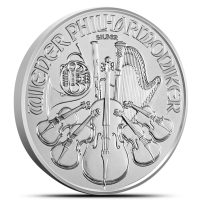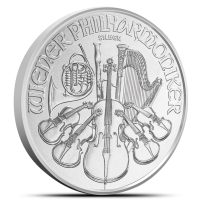



Arguably Europe’s most popular silver bullion coins, and one of the best-sellers in the world, the Austrian Silver Philharmonic is part of a robust series of bullion coins from the Austrian Mint. The official bullion coins of the nation, the Austrian Philharmonic series includes three precious metal options and comes with unique variations in the silver bullion issue each year. Now’s your chance to learn more about these beautiful coins.
The Austrian Silver Philharmonic coin debuted in 2008 as the second option in the long-running Austrian Philharmonic collection. The Gold Philharmonic is the lead coin in the series and was the original offering when the collection debuted in 1989. Chief Engraver of the Austrian Mint, Thomas Pesendorfer, developed the designs used on both the obverse and reverse of the Austrian Philharmonic coins in 1989. The same designs are not only used on the obverse and reverse each year, but also across the Silver Philharmonic and Platinum Philharmonic coins as well.
While the Gold Philharmonic features a 1 oz coin and various fractional-weight options, the Silver Philharmonic is like many other major silver bullion coins on the market. You’ll only find the Austrian Silver Philharmonic available in 1 oz silver.
Mr. Pesendorfer used the Vienna Philharmonic Orchestra as the inspiration for the design elements found on both the obverse and reverse sides of the coins in this collection. The obverse side of all Austrian Silver Philharmonic coins includes the image of the pipe organ located within the Musikverein. Also known as the Golden Concert Hall, this is the home theater for the Vienna Philharmonic when it performs and it is located in the Innere Stadt borough of Vienna, the national capital of Austria.
On the reverse of the coins is the image of various musical instruments used by members of the Vienna Philharmonic. Included in the design is a cello in the center, which is flanked on either side by two violins (totaling 4 in all). Behind it are images of the harp, flute, bassoon, and French horn.
Both sides of the coin have engravings in German, which is the official language of the nation of Austria. These engravings read “Wiener Philharmoniker” on the reverse, which translates easily as “Vienne Philharmonic.” On the obverse are engravings of “Republik Osterreich” and “1 Unze Feinsilber.” These translate as “Republic of Austria” and “1 Ounce Fine Silver.” The coin’s year of issue and face value in Euros (€1.50) are also found on this side. All Austrian Silver Philharmonic coins contain 1 Troy oz of .999 pure silver.
The Austrian Mint does not always publish annual mintage figures for its Austrian Silver Philharmonic program, but many of the available years do have mintage figures available for investors to look back on. The coins were met with immediate popularity when released in 2008, with the following mintage figures for each year from 2008 to 2016:
The Silver Philharmonic coins are the highest minted and most well-known silver bullion coins on the European continent. During the five-year span of 2008 to 2012, the Austrian Silver Philharmonic sold a total of 54 million coins.
When originally released from the Austrian Mint, the Silver Philharmonics are available inside of individual protective plastic or two different bulk options. Multiples of 25 coins are housed inside of tubes, while multiples of 500 coins come in Monster Boxes with a total of 25 tubes. Special-issue versions of the Austrian Silver Philharmonic, such as gilded and colorized coins, are available inside of individual display boxes.
The Austrian Silver Philharmonic coin is one of the many popular silver bullion coins also available with distinct variations meant to attract collectors to the series as well. Since the Silver Philharmonic lacks an annual proof release, bullion coins are often modified with distinct features to generate collectible interest in the coins as well. The two most common forms are:
Chief Engraver Thomas Pesendorfer used the cultural icon of Austria that is the Vienna Philharmonic as the inspiration for the design of the nation’s official bullion coin series. The Vienna Philharmonic is based at the Musikverein in Vienna and its members are chosen from the Vienna State Opera to perform in the orchestra. The selection process is a lengthy one and requires demonstration of musical capabilities over a minimum of three years’ performance with the opera and ballet. Though the Vienna Philharmonic Orchestra was formally founded in 1842, operatic performances were taking place in Vienna on a random basis as early as the first years of the 1830s.
If you are interested in buying silver from the Austrian Silver Philharmonic collection, JM Bullion has you covered. Feel free to reach out to our customer service team at 800-276-6508, or connect with us online using our live chat and email address options.